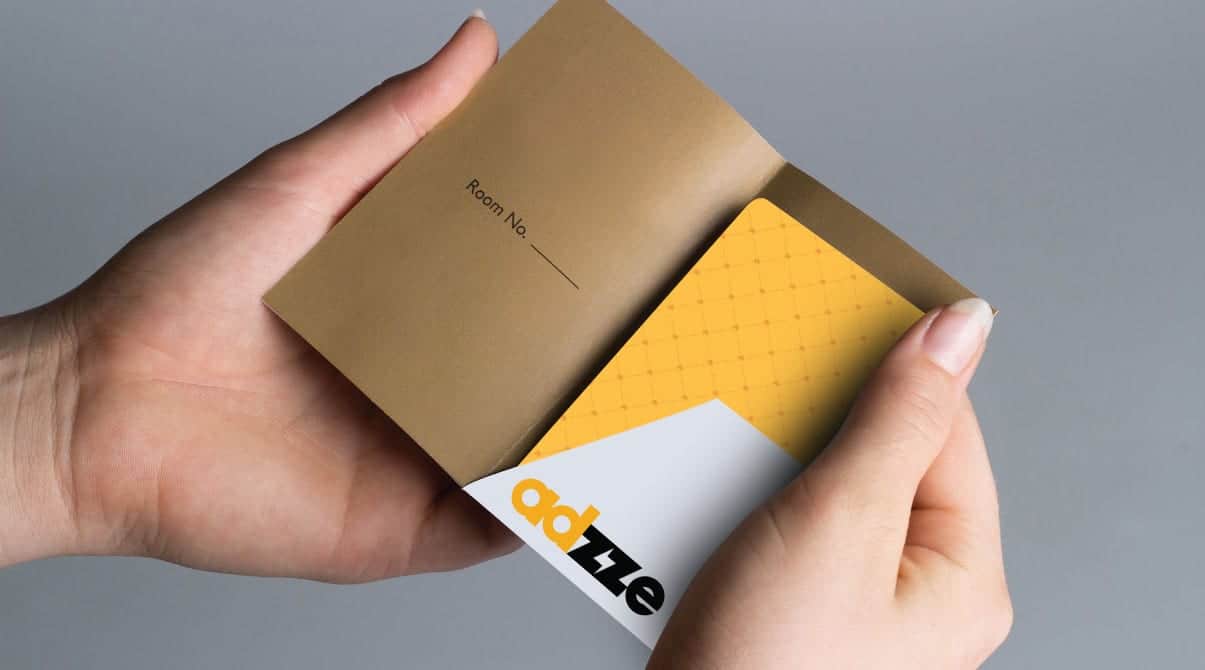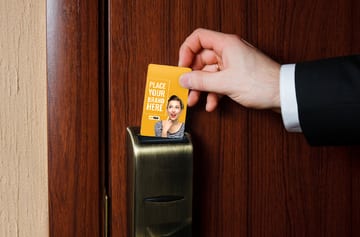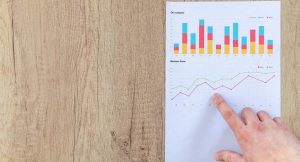Introduction: Have you ever considered how often hotel guests handle their key cards during a stay? Now, imagine your brand message being part of that experience.
Advertising on hotel key cards is a subtle yet powerful tool to connect with an affluent audience. Are you curious about how this under-the-radar approach can give your brand prolonged visibility? Let’s dive into the potential of in-hand advertising using hotel key cards.
Want more details? Request our Media Kit now!
What is In-Hand Advertising on Hotel Key Cards?
In-hand advertising, particularly on hotel key cards, is a form of targeted marketing where brand messages are placed directly on guests’ cards throughout their stay. These cards are handled multiple times daily, ensuring consistent exposure to your message. Hotel key cards are functional, but they double as prime real estate for brands looking to reach an affluent and often hard-to-capture audience.
Imagine your brand being seen whenever a guest enters their room or heads to the gym. With this strategy, your brand doesn’t just enter the customer’s mind once; it becomes a part of their entire experience, from check-in to check-out.

The Benefits of Advertising on Hotel Key Cards
Targeting High-Value Audiences: Hotel key card advertising puts your brand directly into the hands of travelers, business executives, and tourists. These are decision-makers and consumers with disposable income, making them the ideal target for premium products or services.
Long-Term Exposure: Hotel guests often stay multiple nights, meaning they interact with the key card—and thus your brand—several times a day. This frequency ensures your message sticks in the mind of the consumer, leading to better brand recall.
Cost-Effective Yet Premium: Compared to other out-of-home (OOH) advertising formats like billboards or digital screens, advertising on hotel key cards offers a cost-effective way to reach a premium audience. The CPM (cost per thousand impressions) is often lower, but the value of the exposure is higher, given the targeted nature of the platform.
Affiliation with Trusted Brands: Associating your brand with well-known hotel chains such as Marriott, Hyatt, or Hilton increases its perceived value. This subtle branding method creates a connection between your product and the trusted, high-quality service offered by these establishments.
Measuring ROI for Hotel Key Card Advertising
To understand the impact of hotel key card advertising, brands need to measure key performance indicators (KPIs) like reach, impressions, and cost-effectiveness. Here’s how you can break it down:
Reach: The first factor to consider is the number of guests staying at the hotel. Hotels can provide occupancy rates, helping advertisers estimate the total potential audience.
Impressions: Unlike one-time exposure in traditional formats, guests handle their hotel key cards multiple times a day. Multiply the number of guests by an estimated 5-7 interactions per day and by the length of their stay, and you’ll have a strong impression estimate.
Cost per Thousand Impressions (CPM): Hotel key card advertising typically offers lower CPMs compared to other OOH formats. For example, while billboards in prime locations can charge as high as $20-$50 CPM, hotel key cards can often deliver impressions at a fraction of that cost.
Conversion Tracking: Adding a QR code or special promotional code to your hotel key card can help track conversions directly linked to your advertising. If a guest uses the code, you can tie that purchase or engagement back to your hotel key card campaign, providing tangible ROI data.
5 Key Use Cases for Hotel Key Card Advertising
Luxury Retail: High-end retailers can leverage hotel key cards to promote exclusive sales or collections. The affluent guest demographic is perfect for brands offering luxury goods.
Tourist Attractions: Local tourist spots can use hotel key card advertising to promote events, theme parks, or museums. Since guests are likely to visit nearby attractions, this format provides a convenient way to connect with potential visitors.
Dining and Hospitality Services: Restaurants, bars, and cafes near the hotel can advertise special offers or happy hours. Imagine being a guest, checking into your room, and seeing a 20% discount at a nearby restaurant right on your key card—tempting, right?
Health and Fitness Brands: Many hotel guests use gyms or spa services, so health and wellness brands can target a health-conscious audience directly through hotel key cards, promoting gym memberships, supplements, or fitness classes.
Event Marketing: Conferences and large events hosted at hotels provide the perfect opportunity to advertise upcoming seminars, networking events, or entertainment right on the key card.
FAQs
Why choose hotel key card advertising over traditional OOH? Hotel key card advertising offers targeted, repeated exposure to an affluent audience at a lower CPM than billboards or digital screens.
What types of brands benefit most from hotel key card advertising? Luxury brands, local attractions, restaurants, health and wellness centers, and event organizers can all benefit from advertising on hotel key cards.
How do I measure the success of a hotel key card campaign? Through unique promo or QR codes on the key cards, you can track impressions, reach, and conversions.
What is the typical cost for a hotel key card advertising campaign? Costs vary depending on the hotel chain and geographic location, but the CPM is generally lower than other OOH platforms.
Can I customize my ad for different hotel chains or regions? Absolutely! Ads can be tailored to fit the audience of specific hotel chains or regions, providing hyper-targeted marketing opportunities.
Conclusion
Advertising on hotel key cards presents a unique and innovative way to place your brand message into the hands of travelers. It provides both high-frequency exposure and a targeted, premium audience. With low costs and high engagement potential, this advertising format should be a key part of any brand’s OOH strategy.
Interested in learning more? Request our Media Kit today and watch the video below to see how hotel key card advertising can work for you.
For the cost of 30 seconds TV ad (average cost) you can advertise on key cards in 100 different hotels for 1 month delivering you message in the hands of 97,000 consumers.
Other Examples of Viral Marketing
One emerging trend is In-the-Hand Advertising. This concept relies on placing ads on consumables that the target audience can’t ignore, as they have to hold them. Such consumables can be door hangers, pizza box toppers, prescription bags, drink coasters, Custom Coffee Sleeves, and hotel key cards.
Door Hanger Ads: The advertiser’s message is printed on door hangers and placed on the doorknob of households. Door Hanger Advertising is an unconventional tactics since the audience do not expect to see the ad in their doorknob. The households can be targeted and the advertiser has to ensure the right delivery of door hangers to the targeted addresses. Besides affordability, door hangers deliver unmatched visibility for your brand. Assume you are coming from a busy day at work and have to read some emails on the road. At that moment, a door hanger with a beautifully printed message and logo pops into your sight. Can you miss it? Door hangers delivers better audience engagement.
Coffee Cup Ads: Coffee Cup Ads are a sub-segment of Ambient Marketing and are sometimes recognized as Guerrilla marketing tactics. Ambient media refers to the usage of publicity-grabbing events by utilizing contextual elements of the target groups. The placement of advertising in unusual and unexpected places, often with unconventional methods and being the first or only ad execution to do so. In-the-Hand ads leverage daily consumables as vehicles / ad spaces to trigger a surprise effect in the audience. These vehicles can be pizza boxes, drink coasters, prescription bags, coffee cups, dry cleaner hangers, door hangers.
Pharmacy Bags Ads: Healthcare providers that leverage their competitive advantage offer better care to their clients. Typically, healthcare providers compete in terms of the quality of care offered and the cost. As such, the most competitive hospital or healthcare practitioner is the most affordable and with the best quality of care. By advertising, you get more clients, and you grow the top line of your business. Eventually, the higher top-line enables you to improve the business’s competitive advantage. The concept of leveraging prescription bags or pharmacy bags is an effective tool to target healthcare providers since it delivers the message in the hand of consumers.
Coaster Advertising: Often, people visit places of drinking because they are looking to escape the stress of work and family. As such, one can conclude that users find peace in bars. During this period, a person drinking alcohol will be very much interested in a bar coaster with a special message. Usually, people have little to do when drinking. Hence, there is a high probability that they will read and assimilate the message on the coaster. The concept of using coasters is a unconventional tactics that surprises the audience in a relaxing environment delivering a high brand recall.
Sources:
1. Nielsen’s 2018 Audience Report. The State of Traditional TV: Updated With Q3 2018 Data
2. Arris’ Consumer Entertainment Index






